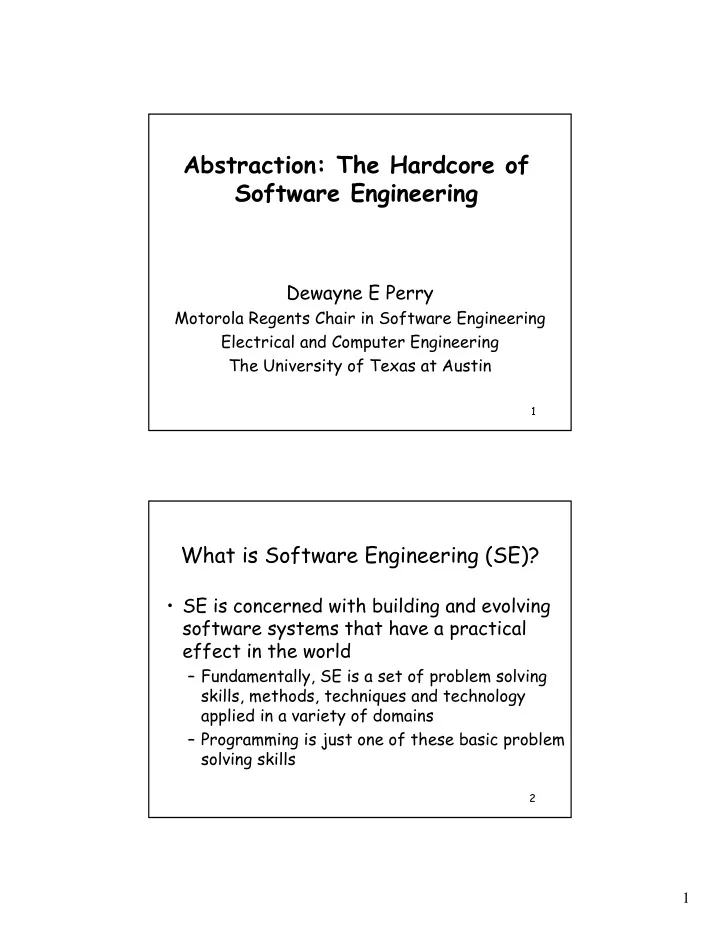

Abstraction: The Hardcore of Software Engineering Dewayne E Perry Motorola Regents Chair in Software Engineering Electrical and Computer Engineering The University of Texas at Austin 1 What is Software Engineering (SE)? • SE is concerned with building and evolving software systems that have a practical effect in the world – Fundamentally, SE is a set of problem solving skills, methods, techniques and technology applied in a variety of domains – Programming is just one of these basic problem solving skills 2 1
Basic job of a Software Engineer • Discover, create and build/evolve abstractions and behaviors • Effectively evaluate and decide among alternative abstractions/solutions To do this we use – Theories or models that we use or create • From standard well understood domains • For new domains we do not understand well 3 Basic job of a Software Engineer – Experience • Feedback, either directly or from users • Experimentation, engineering or scientific – Process • Problems solving methods and techniques • Technologies appropriate to the product and to the methods and techniques • Organizational and cultural structures - 4 2
Software Engineering Research • Discover, create and build new abstractions to help software engineers • Evaluate the effectiveness and utility of these abstractions for engineering software systems • Discover, create and evaluate effective measures for comparing and evaluating abstractions, behaviors and solutions 5 Abstractions • SE, as any engineering discipline, is a discipline of design – Brooks’ goal: conceptual integrity of design – Abstractions are our fundamental intellectual tool for design • Simplification • Generalization • Codification • Satisficing 6 3
Abstractions • For the SEs, abstractions – Are the primary means of managing complexity – Provide basic domain specific concepts • For SE Researcher, abstractions – Provide the primary means to help SEs to think about how to architect, design, build and evolve software systems – Remove accidental underbrush and simplify SW development 7 Whither Structured Programming? • Basic set of abstractions for programming – Basic set of programming actions • Complete • Orthogonal – Well defined semantics, composition and proof rules – Disciplined control flow – Static structure reflects dynamic structure – Basis for additional needed abstractions • Eg, separation of normal and abnormal (exceptions) 8 4
Some Useful Abstractions • Problem versus solution space • Virtual machines • Product families • Essential versus accidental characteristics • Components and connectors • Computations versus behaviors 9 Problem vs Solution Space • SE’s often too focused on solutions • Emphasis on problem domain – What rather than how – Problem discourse – Domain abstractions • In the world rather than in the machine • Jackson: shape of the solution should reflect the shape of the problem 10 5
Virtual Machines • Interfaces as little languages • Coherent and related set of abstractions • Layering – with increasingly rich concepts – with increasingly higher level languages • Domain specific machine and language • Encapsulated implementations - changeable 11 Product Families • Parnas: Planning for change • Commonality vs variability • System as a sequence of family members – Some parts are invariant – Some change • Exploit commonality to reduce maintenance • Basis for things to come – Product line architecture 12 6
Essential versus Accidental • Brooks: Critical distinction • Essential - need to be managed – Basic facts of life • Accidental - need to be remedied – Eg, – Inadequate abstractions, expressions – Inadequate modes of expression – Inadequate support and resources – Inadequate knowledge 13 Components and Connectors • Perry/Wolf: Logical rather physical distinction • Connectors represent interactions – Communication – Coordination – Mediation • Components represent computations and behaviors to be composed • Connectors relate and regulate the behavior of the composed components • Possible: composable non-functional properties 14 7
Computations vs Behaviors • Turski: critical distinction • Computations – Bounded, neat problems – Underlying theory available – Admit of clean, theoretically nice solutions • Eg, Misra’s composition of concurrent programs • Behaviors – Unbounded, messy problems – Little theory available – often make it up as we go – Harder to formally describe and reason about 15 Evaluation • Few agreed on measures – Still at level of naïve art critic • I know what I like • I’ll know it when I see it – Tend to rely on experience (anecdotal) – Poor construct validity • Eg, cohesion – Little agreement on effectiveness and reliability of metrics 16 8
Creating Effective Evaluations • Tends to be I have a dream paradigm • Too little theory to go on • Experimental side of SE (and CS) very immature – Lack of understanding of basic experimental issues: design, validity, analysis – Lack of standard designs and measures • Virtually no replicated experiments • A long way to go yet 17 Conclusions • Abstractions and evaluations fundamental to software engineering • Abstractions, evaluations and the creation of effective measures fundamental to software engineering research. • Doing well in the abstractions department • Doing poorly in the evaluations department • Much worse in creating effective measures 18 9
Recommend
More recommend